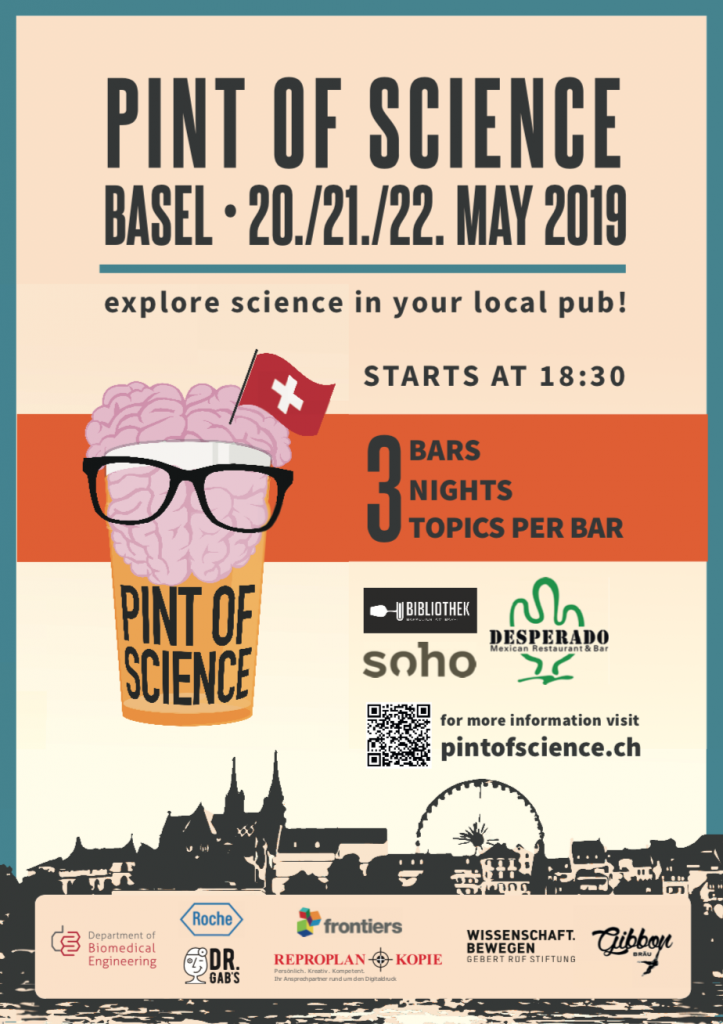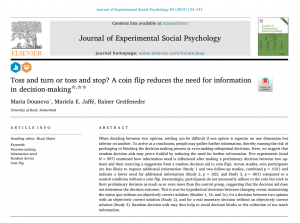Rainer Greifeneder, Mariela Jaffé, and I have a new paper out in the Journal of Experimental Social Psychology, in which we examine how simply seeing a random device such as a coin flip providing a suggestion can influence the need for information before settling for a decision. No matter whether it’s a hypothetical decision about prolonging someone’s contract, judging which one of two backpacks costs more, or deciding which medical charity receives money – coin participants are less likely to request additional information and indicate a lower need for additional information compared to control participants without a coin flip. Interestingly, participants do not necessarily adhere to the coin but stick to their preliminary decision as much as or even more than the control group. A coin flip may thereby help to avoid decision blocks or the collection of too much information.
Archive for May, 2019
Ian Krajbich
On 16 May, Dr Ian Krajbich (a neuroeconomist at the Department of Psychology, Ohio State University, USA) visits to give a talk in the SWE Colloquia series.

The neural dynamics of attention and choice
When making decisions, people tend to shift their attention back and forth between stimuli, choosing options that they look at more overall and immediately prior to their responses. These relationships, and others, are well-described by sequential sampling models that assume that evidence for a given alternative is collected over time in proportion to its subjective value, amplified by attention. Furthermore, findings from a number of studies support a causal effect of attention on choice. What is unclear is how this attention-guided decision process unfolds in the brain. Here we designed a task that draws out the decision process, allowing us to control the stream of evidence seen by the decision-makers. Using this approach, we were able to clearly dissociate neural signatures associated with evaluating the on-screen evidence vs. integrating all the evidence needed to decide. We find that these signals are isolated to separate regions of the brain. Importantly, we find that both signals are affected by visual attention, demonstrating that gaze affects the stored representations of past evidence. In another study, we causally manipulate attention-related brain activity using transcranial magnetic stimulation and find that this impacts the effects of gaze on choice in ways predicted by our model. Together, these studies establish a brain network guiding gaze-weighted evidence accumulation for value-based choice.
pint of science

3 bars, 3 nights, and 3 (scientific) topics (per bar and night) taking place 20-22 May, 2019. Program for Basel events available here.
Evelyn Maeder and Susan Yamamoto
Dr Evelyn Maeder (left) and Susan Yamamoto, Forensic Psychology Research Centre, Carleton University, Canada, will be giving a talk on 9 May as part of the SWE colloquium on Thursday 9 May (12:00-13:00, Seminar Room 00.008, ground floor, Missionsstrasse 64a).


Moral intuitions and jury decision-making
Researchers have developed two theories of how individuals engage in moral judgments – rationalists hypothesize that moral judgments are the outcome of explicit cognitive reasoning, whereas intuitionists posit that they are automatic, involuntary, and culturally-driven. Chief among intuitionist models is moral foundations theory, which proposes five moral foundations that are culturally-invariant and operate beneath conscious awareness (Haidt & Graham, 2007).
Across four experiments, we investigate the role of moral foundations in prospective jurors’ deliberations and verdict justifications in simulated criminal trials. Using Linguistic Inquiry Word Count (LIWC) software, we coded jurors’ deliberations (in group studies) and verdict justifications (in individual studies) for words related to each of the five moral foundations and conducted a follow-up sentiment analysis. Our results reveal that jurors who reach different verdicts employ moral foundations differently in their reasoning. Sentiment analysis further suggests that use of anger-related language is associated with greater likelihood of a guilty verdict.
